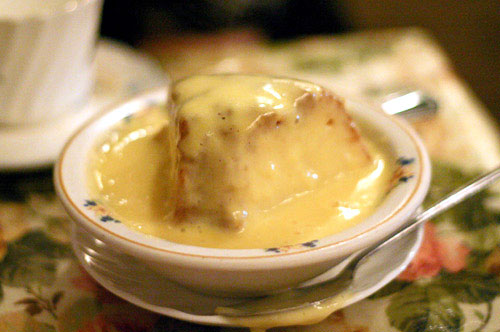A little-known phenomenon of New York Fashion Week is the transformation of Tea & Sympathy into the second home of London’s fash pack. Designers, photographers, models and stylists stand in line longer than they would for a Gucci pre-sale, turning our humble bench into the hottest unofficial ticket in town.
As the week winds down, what we like to call “Mum’s grub” syndrome kicks in. It is a sad fact that part of a model’s job is staying skinny, and we can’t help but notice that through the week these beautiful, young things will push around a plate of Ab Fab Salad under the hawk-like stares of their agent. But once the catwalk has been walked, and they’re out of the spotlight, these girls sure know how to treat themselves – and for those after a taste of home, we’re the first port of call.
Sausages, pies, mac & cheese and pasties abound, all with extra bacon, double mash and gravy. And when the main course is served, there’s always room for dessert. Which is why this week we bring you the recipe for a firm fashionista’s favorite… Treacle Pudding!
FYI. A few years back, Kate Moss put away TWO helpings of this dessert – and that was after a plate of Bangers & Mash!
Treacle Pudding
Treacle is pronounced TREE-cull. This recipe can be made with black treacle instead of golden, if you wish. There are many different variations of this pudding, some made with suet and some not. We use Tate & Lyle golden syrup, which is a refined sugar product that tastes like a cross between honey and molasses. We sell both in store; see below for more details.

Here's a snap from our restaurant. Smothering in custard is optional, but we think the best way to have it.... And we know Kate agrees! Image courtesy of Serious Eats New York.
Serves 8-10
Preparation Time: 45 minutes
1 recipe sponge batter for Victoria Sandwich
1 1/4 cups Tate & Lyle golden syrup (a little extra will do no harm)
Hot custard, optional
- Preheat the over to 350F.
- Butter and flour a 10-inch round Bundt pan.
- Prepare the sponge batter as instructed.
- Pour the syrup into the pan, then spoon in the batter, gently smoothing the top with a spatula.
- Bake for about 30 minutes, the sponge should be golden on top.
- Remove the cake from the oven and let it cool for 2-3 minutes. Place a plate on top of the Bundt pan, then quickly but firmly turn the plate and pan upside down to release the cake onto the plate. You may need to loosen the edges very slightly with a knife before you flip it.
- Serve with hot custard, if you like.

